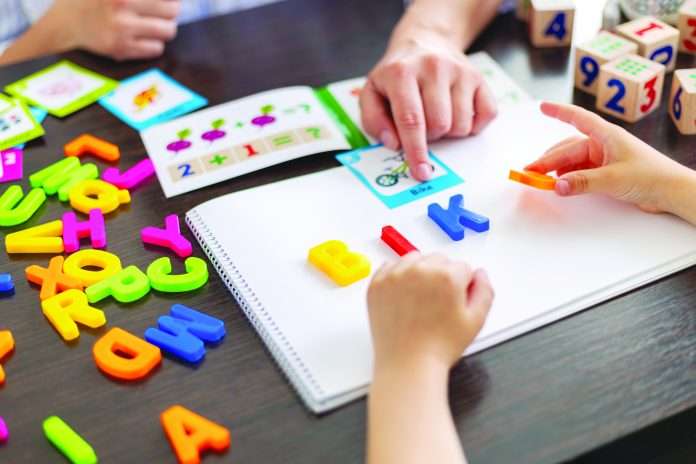by Rima Madi, ECE
The early years of life are a critical period in child development due to the brain’s plasticity and the rapid formation of neural connections. During this time, children absorb information quickly and are especially receptive to language and literacy. As Raban and Scull (2013) stated, “The early years are a crucial period for literacy and numeracy acquisition” (p. 101). This developmental stage lays the foundation for formal learning and presents an optimal window for nurturing early literacy. From infancy through the toddler years, children begin to grasp the basic components of letters and numbers that are essential for later academic success.
Early literacy begins well before children enter school. Parents and caregivers play an essential role by integrating reading, singing, storytelling, and conversation into daily routines. These interactions not only foster early language and literacy development but also promote social bonding and secure attachments. Environments that prioritize relationships and provide consistent opportunities for language-rich exchanges help children build the skills needed to succeed in school and beyond.
Children develop early literacy within the context of their socio-cultural environment, where they learn language through meaningful participation in family and community life. As Raban and Scull (2013) note, equal access to resources and culturally embedded practices allow children to grasp the deeper meanings and uses of language. According to the Canadian Paediatric Society (2024), “Literacy is a key social determinant of health that affects the daily socioemotional lives of children and their economic prospects later in life” (p. 1). When children are immersed in print-rich environments—where books, signs, and labels are part of everyday life—they begin to understand that written language carries meaning.
Although several factors influence a child’s reading ability, including memory, intelligence, and social class, the most consistent predictors of reading success are phonological awareness, print knowledge, and oral language. Phonological awareness is the ability to recognize and manipulate the sounds in spoken words. Print knowledge includes recognizing letters and understanding how print works. Oral language skills—such as vocabulary and sentence formation—support comprehension and expression. Wilson and Lonigan (2010) found that children with stronger vocabularies are more likely to become fluent readers.
Children who experience limited literacy opportunities early on may face significant challenges. Difficulties in reading and writing can lead to academic frustration, reduced confidence, and delayed communication skills. These struggles can have social and emotional consequences, affecting children’s ability to interact with peers. As Raban and Scull (2013) observed, “Parents are seeking help from professionals for their children whose self-esteem and behaviour problem are a consequence of learning difficulties…” (p. 102). Westrupp et al. (2020) linked language delays with behaviour and emotional issues such as hyperactivity, inattention, and anxiety.
To prevent these outcomes, early intervention and structured literacy instruction are essential. According to the Canadian Paediatric Society (2024), well-designed literacy curricula—including systematic teaching of phonemic awareness, phonics, and early word reading—can prevent or resolve difficulties in up to 95% of children.
At the same time, it is vital to maintain a play-based, developmentally appropriate approach. Intentional literacy-rich play allows children to explore language in joyful and meaningful ways. Activities like rhyming songs, storytelling with props, and word games support phonemic awareness and vocabulary growth. Picture book read-alouds paired with reenactments offer multiple modes for children to engage with language. Field trips further support vocabulary by connecting words with real-world experiences. As Wohlwend (2021) explains, “Field trips embed language in actions, sensations, and memories to contextualize vocabulary” (p. 3).
In conclusion, early literacy development is foundational to lifelong learning, and integrating play-based strategies ensures that learning is engaging and effective. When educators and families collaborate to create supportive, literacy-rich environments, children are empowered to become confident and capable learners prepared for future success.
References
Canadian Paediatric Society. (2024). Promoting early literacy: A guide for pediatric care providers. https://cps.ca.
Raban, B., & Scull, J. (2013). Literacy and numeracy: A review of the literature. In S. Suggate & E. Reese (Eds.), Contemporary debates in childhood education and development (pp. 101–113). Routledge.
Westrupp, E. M., Healy, E., McKean, C., Goldfeld, S., & Mensah, F. K. (2020). Longitudinal associations between vocabulary and externalizing and internalizing behaviour problems in the early life course. International Journal of Epidemiology, 49(1), 354–364. https://doi.org/10.1093/ije/dyz248.
Wohlwend, K. E. (2021). Playing to read: The role of play in literacy development. In M. J. White & L. T. Ritchie (Eds.), Reimagining play for early childhood (pp. 1–20). Teachers College Press.










